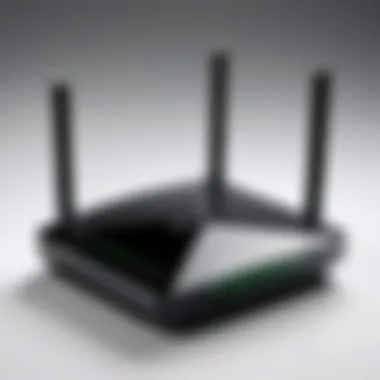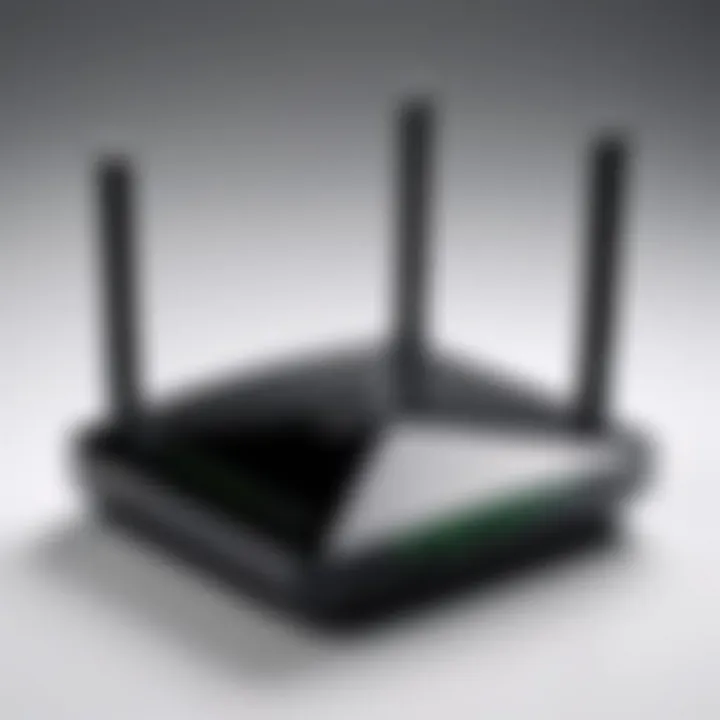Evaluating 200 Mbps Routers: Features & Performance


Intro
In the digital age, the demand for consistent and high-speed internet connection continues to rise. Routers play a critical role in this ecosystem, enabling users to connect multiple devices and access the web seamlessly. This analysis focuses on routers that support speeds of up to 200 Mbps. Understanding the features, performance, and user experience associated with these routers is essential for IT professionals and tech enthusiasts alike.
The following sections will scrutinize key specifications and unique selling points, performance metrics through benchmarking, and real-world usage scenarios. By delving into these elements, our aim is to provide a comprehensive understanding that will aid professionals in making informed networking decisions.
Features Overview
Key Specifications
Routers capable of delivering 200 Mbps typically have several common specifications that define their capabilities. These include:
- Wi-Fi Standards: Most modern routers adhere to the 802.11ac or the newer 802.11ax (Wi-Fi 6) standards, which facilitate higher data rates and improved network capacity.
- Processor Power: A robust CPU and sufficient RAM are crucial for handling multiple connections effectively. Often, dual-core processors are found in mid-range to higher-end models.
- Number of Antennas: A higher number of antennas improves the router's performance by enhancing range and signal stability.
Unique Selling Points
When evaluating routers that support 200 Mbps, certain features stand out, providing a competitive edge:
- Quality of Service (QoS): This feature allows prioritization of bandwidth allocation, ensuring that critical applications receive adequate resources, essential for gamers and streamers.
- Beamforming Technology: This enhances signals directed towards specific devices rather than broadcasting in all directions, improving connectivity and speed.
- Security Features: Advanced security protocols, such as WPA3, provide better protection against unauthorized access, critical for both home and office networks.
"A router's security features are as important as its speed capabilities, especially in an era where digital threats are rampant."
Performance Analysis
Benchmarking Results
Measurements of router performance can be observed through various benchmarking tests. Testing involves evaluating throughput under different conditions. High-quality routers usually maintain their advertised speeds in optimal conditions and perform well in congested environments too.
Real-world Scenarios
In practical scenarios, performance varies based on factors like distance from the router, the number of connected devices, and interference from physical obstructions. In setups with multiple simultaneous users, routers with effective QoS features demonstrate better performance by managing bandwidth effectively.
Ultimately, understanding these aspects is crucial for anyone involved in IT management or home networking setups. The choice of a router will invariably impact user experience, productivity, and overall network efficiency.
Prelude to Routers and Internet Speeds
In the contemporary digital landscape, understanding the role and functionality of routers is crucial for both individual users and IT professionals. Routers serve as the essential link between home or office networks and the vast expanse of the internet. Their capability to manage and distribute internet connection significantly affects user experience, particularly when operating at higher speeds such as 200 Mbps. This article aims to shed light on the intricacies of routers that support 200 Mbps, underscoring their relevance in various networking environments.
One of the primary benefits of having a router that supports such high speeds is the enhanced user experience during online streaming, gaming, and remote work. High-speed internet promotes seamless connections, minimizes lag, and ensures that multiple devices can be engaged without compromising performance. Understanding the nuances of these routers also aids in making informed purchasing decisions, as users can identify features and specifications aligned with their specific needs.
Definition of Routers
A router is a networking device that forwards data packets between computer networks. It connects multiple devices, allowing them to communicate with each other and access the internet. Routers operate by analyzing the incoming data, determining the best path for it to travel, and forwarding it to the appropriate destination. This process is vital for efficient network communication.
Routers can be wired or wireless, with wireless routers being more popular for home use due to their convenience. Modern routers come with features such as built-in firewalls and network management tools, providing users with a secure and manageable network environment.
Understanding Internet Speed Measurements
Internet speeds are typically measured in megabits per second (Mbps). This metric indicates how fast data can be transferred between the internet and a user's device. Higher Mbps means faster speeds, which translates to quicker downloads, smoother video streaming, and more reliable connections during online gaming. It is crucial for users to understand that various factors influence internet speed, including the type of connection technology used (fiber, cable, DSL) and the quality of the router itself.
Different activities require varying bandwidth. For instance, standard browsing may only need 1-5 Mbps, while HD video streaming can require 5-25 Mbps. As a general guide, a router capable of supporting 200 Mbps is well-suited for households with multiple users engaging in bandwidth-intensive tasks simultaneously.
The power of a router lies not just in its maximum speed support, but also in its ability to manage traffic efficiently, ensuring optimal performance under various conditions.
The Importance of Mbps Support
In today’s fast-evolving digital landscape, understanding the need for routers that can support speeds of 200 Mbps is crucial. As user demands grow, so do the expectations regarding network performance. High-speed internet is no longer a luxury but a necessity in various environments such as homes, small businesses, and remote work setups. This section delves into the key elements that underline the significance of 200 Mbps support in routers.
User Demands and Expectation
The increase in online activities has shifted user expectations towards higher bandwidth requirements. Streaming high-definition videos, participating in video conferences, and gaming online simultaneously demand substantial data speeds. A router that supports 200 Mbps enables users to manage these tasks efficiently without lag or interruptions.
- Streaming Services: Platforms like Netflix and YouTube benefit immensely from a stable connection. A 200 Mbps router ensures multiple devices can stream content without buffering.
- Gaming: Online gaming requires a low-latency connection. Routers capable of supporting at least 200 Mbps offer enhanced gaming experiences, preventing slowdowns during crucial moments.
In essence, the importance of this speed support is clear. Users expect seamless operation across various devices, and a router that meets these demands stands to improve user satisfaction significantly.
Network Traffic and Performance
Today's networks experience varying levels of traffic that pose challenges to performance. A 200 Mbps router helps maintain stability, allowing for better traffic management.
- Increased Concurrent Users: Homes and offices often have multiple devices connected simultaneously. A robust router can sustain throughput even while multiple devices stream content or download files.
- Quality of Service (QoS) Features: Many modern routers offer QoS functionalities, allowing the prioritization of certain connections. For instance, during video calls, bandwidth can be directed to ensure clarity.
A well-implemented 200 Mbps connection can significantly enhance overall network performance and user experience.


Moreover, understanding these factors ensures that users select the right technology that fits their needs. This decision impacts not only the user's daily experiences but also the long-term capabilities of their home or office network.
Key Features to Consider
When selecting a router that can efficiently support speeds of 200 Mbps, understanding the key features becomes essential. These features determine not only the performance but also the longevity and suitability of the device for specific user needs. Knowledge about wireless standards, security protocols, and connectivity options ensures that IT professionals and tech enthusiasts make informed decisions when investing in networking hardware.
Wireless Standards and Compatibility
In the sphere of wireless networking, standards play a pivotal role. Routers are often categorized based on IEEE 802.11 standards. For 200 Mbps support, look for routers that adhere to at least the 802.11n and preferably 802.11ac or 802.11ax standards.
- 802.11n: Offers good speed but may struggle in congested environments.
- 802.11ac: Provides superior performance in medium to large spaces. Ideal for high-definition streaming and online gaming.
- 802.11ax: Also known as Wi-Fi 6, this standard is designed to handle multiple devices better and is more efficient in crowded networks.
Compatibility with various devices also matters. Ensure that your router can work seamlessly with both newer and older devices, including smart home gadgets, computers, and mobile devices.
Security Features
In today's digital landscape, security cannot be overlooked. Routers must come equipped with robust security features to protect confidential data and maintain user privacy. Key protocols include:
- WPA3 Encryption: This is the latest security protocol, enhancing protection against unauthorized access.
- Firewall Protection: A built-in firewall helps to filter out malicious traffic, providing an additional safety layer.
- Guest Network Capability: This feature allows users to create a separate network for guests, ensuring that personal devices remain secure.
Moreover, regularly updating the router's firmware is equally important. Manufacturers frequently release updates to patch vulnerabilities, so staying current is crucial.
Ports and Connectivity Options
The variety of ports and connectivity options can significantly influence a router’s versatility.
- Ethernet Ports: A router should have multiple Ethernet ports for wired connections. This is vital for devices requiring stable internet, like desktop computers and gaming consoles.
- USB Ports: USB 2.0 or 3.0 ports can also add functionality. Users can connect external hard drives, allowing for networked storage solutions.
- Quality of Service (QoS): A router with QoS settings allows prioritization of bandwidth for specific applications or devices. This ensures that essential tasks receive the necessary speed, optimizing performance during peak usage.
A well-rounded router not only enhances connection speeds but also provides a stable and secure networking environment.
Performance Metrics of Mbps Routers
When evaluating routers that support 200 Mbps, performance metrics are crucial. They determine how well routers can deliver advertised speeds under various conditions. By understanding these metrics, users can make informed choices, ensuring optimal network performance for their needs.
Latency and Jitter
Latency is the time it takes for data to travel from the source to the destination. In the context of a router, this means how quickly it can respond to requests. Ideal latency for a good user experience should be under 20 milliseconds, as higher latency may disrupt online gaming, video calls, or other real-time services.
Jitter, on the other hand, refers to the variation in latency over time. High jitter can result in packet loss, leading to choppy video streams and disrupted audio during calls. Routers designed to support 200 Mbps should maintain low levels of both latency and jitter to provide a consistent experience.
"Low latency and jitter are essential for maintaining high-quality connections, especially in demanding environments such as gaming and streaming."
Factors affecting latency and jitter include:
- Router specifications and age
- Network congestion
- Physical distance between the router and device
- Quality of service (QoS) settings
To achieve an optimal experience, it is essential to test latency and jitter using various tools for accuracy. This helps in understanding how different routers perform in real-world scenarios.
Throughput Tests
Throughput is the actual speed at which data is successfully transmitted over the network. Unlike advertised speeds, throughput indicates the performance users can actually expect in daily use. For routers that support 200 Mbps, throughput testing can reveal how well a router can handle multiple devices without compromising speed.
Throughput tests are best conducted in a controlled environment, keeping variables consistent. To do this effectively, consider:
- Using Ethernet connections when possible to eliminate wireless interferences.
- Conducting multiple tests at different times to account for network congestion variations.
- Utilizing testing tools like iPerf or Speedtest to verify performance.
Moreover, it is important to evaluate the throughput across various devices and distance from the router. This ensures the selections made will accommodate typical usage scenarios within homes or businesses.
In summary, understanding performance metrics such as latency, jitter, and throughput is fundamental for selecting a router. A thorough analysis allows IT professionals and tech enthusiasts to make decisions based on actual performance rather than solely marketing claims.
Best Routers for Mbps
The selection of routers capable of supporting 200 Mbps speeds is crucial for ensuring optimal internet performance. In today’s digital age, users require reliable access to high-speed internet for various activities like streaming, gaming, and remote work. Choosing the right router not only enhances the user experience but can also significantly impact the overall productivity in households and small businesses. The focus on identifying the best routers for this speed enables users to make informed decisions based on their specific needs.
Top Recommendations
When evaluating routers, a few models consistently stand out due to their performance, compatibility, and features. Here are some noteworthy options:
- Netgear Nighthawk RAX50: This dual-band router supports speeds up to 3000 Mbps. It offers advanced features like MU-MIMO technology and QoS management, making it ideal for households with multiple users.
- TP-Link Archer AX50: Supporting both 2.4 GHz and 5 GHz bands, this router provides a good combination of speed and range. With its affordable price point, it is suitable for budget-conscious buyers looking for reliable performance.
- ASUS RT-AX56U: Known for its easy setup and strong security features, the ASUS router is perfect for tech enthusiasts. It supports the latest Wi-Fi 6 standards and effortlessly handles multiple devices simultaneously.
- Linksys EA7300: This option provides solid performance for streaming and online gaming. Its design includes USB ports for external storage devices, adding extra functionality.
Evaluating the features of these top routers indicates their ability to maintain 200 Mbps speeds under varying conditions. Performance consistency remains a key criterion, especially in busy network environments.
Brand Comparisons
Understanding the differences between various brands can guide users in selecting the most appropriate router. Each brand showcases unique strengths and weaknesses that cater to different types of users. Here are some insights into popular router brands:


- Netgear: Known for high-performance options, Netgear caters to both casual users and tech-savvy individuals. Their routers often come with advanced features and long-term firmware support, ensuring a future-proof investment.
- TP-Link: A favorite among budget users, TP-Link routers are reliable and cost-effective. They provide solid performance without compromising essential features. Their user-friendly app makes setup and management easier for non-technical users.
- ASUS: This brand is recognized for pushing technological envelopes. ASUS routers typically include features like robust parental controls, security protocols, and easy mesh networking capabilities. Their performance tends to attract gamers and high-demand users.
- Linksys: Linksys offers a blend of user-friendly features and robust functionality. They are well-regarded for their reliability and customer support. Their routers are often found in both small business and home setups, striking a balance between performance and ease of use.
Usage Scenarios
Understanding the different usage scenarios for routers that support 200 Mbps is pivotal, especially for IT professionals and tech enthusiasts. Each scenario presents unique demands that highlight the necessity for robust performance. By examining these environments, users can better assess the strengths and limitations of various routers. A clear comprehension of these contexts enhances the decision-making process when selecting the most suitable router.
Home Networking
In a home environment, the demand for fast and reliable internet is essential. Many family members often engage in multiple online activities simultaneously, such as streaming movies, playing video games, and video calling. For these tasks, a router supporting 200 Mbps or more is beneficial. It allows for smooth streaming and minimal buffering.
Here are some important aspects to consider:
- Device Connectivity: Households may have multiple devices connected at once. Routers that can handle many simultaneous connections improve overall performance.
- Coverage Area: Larger homes may require routers with better range capabilities. Ensure that devices receive consistent speed throughout the premises.
- User Requirements: Evaluate specific needs for different family members, from casual browsing to more demanding gaming needs.
Small Business Environments
Small businesses often operate in environments where network reliability is critical to productivity. Employees might rely on cloud-based services, making a high-speed router crucial for operations. A 200 Mbps router can support multiple user connections without significant slowdowns.
Key considerations include:
- Scalability: Small businesses may expand, increasing user demand on their network. Opting for routers with higher bandwidth might be a forward-thinking choice.
- Security Features: Given the importance of data security, routers supporting advanced security protocols can safeguard sensitive information.
- Cost Efficiency: With a budget in mind, it's necessary to find a router that balances speed and cost-effectiveness without sacrificing quality.
Remote Work Setup
The rise of remote work has underscored the importance of reliable internet connections. Employees working from home need stable, high-speed internet to participate in video conferences and access company resources effectively. A router that supports 200 Mbps can be a game-changer in these situations.
Considerations for a remote work setup include:
- Dedicated Connection: A separate router for work can help prioritize bandwidth for professional tasks.
- Quality of Service (QoS): Routers with QoS features can allocate more bandwidth to important applications, ensuring critical tasks run without interruption.
- Flexibility: Mobile router options could be useful for those who might work from different locations.
In summary, understanding the specific usage scenarios for 200 Mbps routers enables users to make informed decisions that best suit their needs. Recognizing the features and performance metrics tailored to home, small business, and remote work environments ensures that the chosen router meets the demands efficiently.
Technological Advances in Networking
In the landscape of internet connectivity, staying ahead means understanding the transformative alterations in router technology. Technological advances in networking have ushered in features that dramatically enhance user experience, performance, and adaptability. In particular, routers supporting speeds of 200 Mbps benefit significantly from innovations such as dual-band and tri-band technologies, as well as mesh networking solutions. These advancements are not merely enhancements; they represent critical shifts in how networks function and respond to increased demands from users.
The relevance of these technological shifts becomes clear when considering the evolving needs of users. A growing number of devices in homes and workplaces require robust internet access. This demand puts pressure on network hardware. Therefore, understanding these advances helps identify routers that can manage high-speed connectivity effectively.
Dual-Band and Tri-Band Routers
Dual-band and tri-band routers signify a significant stride towards managing increasing data traffic. Dual-band routers operate on two frequency bands: 2.4 GHz and 5 GHz. The 2.4 GHz band offers a longer range, while the 5 GHz band delivers faster speeds at shorter distances. This combination allows users to select appropriate bandwidths based on their needs.
On the other hand, tri-band routers introduce an additional 5 GHz band. This extra bandwidth can alleviate congestion during high-traffic periods, making them suitable for homes with multiple users or devices demanding high-speed internet.
- Benefits of Dual-Band Routers:
- Benefits of Tri-Band Routers:
- Flexibility in selecting frequency based on distance and speed requirements
- Reduced interference from neighboring networks
- Enhanced online gaming and video streaming experiences
- Further increased speed during peak usage times
- Improved capacity for simultaneous connections
- Optimal performance in dense environments like offices or smart homes
These routers, coupled with support for 200 Mbps speeds, are integral for users requiring reliable connectivity.
Mesh Networking Solutions
As homes and workplaces grow in size and complexity, traditional routers might struggle with coverage. Mesh networking solutions emerge as a compelling alternative. A mesh network consists of multiple nodes that communicate with each other to cover larger areas and eliminate dead zones. This system ensures a consistent internet signal throughout a property, something essential for modern connectivity needs.
Key aspects of mesh networking include:
- Greater Coverage: Mesh networks can extend beyond the limitations of a single router, reaching distant corners effectively.
- Scalability: Additional nodes can be added easily to enhance coverage without requiring extensive reconfiguration.
- Seamless Roaming: Devices connected to a mesh network can move between nodes without losing connection, which is advantageous for users with multiple devices.
"Mesh networking is a significant improvement in ensuring that every corner of a property enjoys consistent connectivity, offering a solution to modern connectivity challenges."
When adopting either dual-band, tri-band, or mesh networking, it is critical to consider the specific needs of users. Understanding these technological advances is essential for making informed decisions regarding routers capable of 200 Mbps support. These choices lead to optimal network performance, making for a better user experience.
Installation and Configuration
Getting the installation and configuration right is essential for the proper functioning of routers supporting 200 Mbps. This section highlights the significance of following precise setup steps to enhance network reliability and performance.
An improper configuration can lead to subpar internet speeds, connectivity issues, and ultimately user dissatisfaction. By emphasizing the right installation practices, IT professionals can ensure that users get the best experience from their routers.
Initial Setup Steps
The initial setup of a 200 Mbps router is a critical phase where various components come into play. Here are some core steps:
- Placement of Router: Find a central location to place the router. This can minimize dead zones and ensure wider coverage.
- Connecting Hardware: Use an Ethernet cable to connect the modem to the router’s WAN port. Connect devices like computers or gaming consoles to the LAN ports if needed.
- Powering Up: Plug in the power adapter and turn on the router. Wait a few moments for it to boot up completely.
- Accessing Configuration Interface: Open a web browser and type in the router’s IP address, typically found on the router itself or in the manual. This usually defaults to 192.168.1.1 or a similar address.
- Logging In: Use the default username and password provided in the manual. It is advisable to change these after the initial setup for security purposes.
- Configuring Internet Settings: Follow prompts to input your internet connection details. This may include selecting DHCP or PPPoE settings based on your Internet Service Provider (ISP).
- Wireless Settings: Set up the Wi-Fi network name (SSID) and password. Ensure to use WPA3 encryption if supported for enhanced security.
- Firmware Updates: Check for any available firmware updates via the router’s interface. Keeping firmware updated can resolve security vulnerabilities and improve performance.


Completing these steps accurately reduces the risks of issues later on and helps in achieving optimal speed.
Optimizing Performance
Once the initial setup is complete, further optimization of the router is necessary to achieve the best performance at 200 Mbps. Various strategies can be employed to enhance the network experience:
- Change Wi-Fi Channels: If interference exists, switching the Wi-Fi channel can improve connection stability. Tools are available for analyzing channel congestion in the area.
- Update QoS (Quality of Service) Settings: Prioritize bandwidth for specific applications like gaming or video streaming. Adjusting QoS can provide smoother experiences for crucial tasks.
- Enable Band Steering: If using dual-band technology, enabling band steering helps devices automatically connect to the best band, either 2.4 GHz or 5 GHz, based on their needs.
- Modify Antenna Positioning: For routers with external antennas, adjusting their angle can improve signal distribution throughout the space.
- Regularly Restart the Router: A simple routine of restarting can clear any temporary glitches and retain optimum network speeds.
- Use Wired Connections When Possible: For stationary devices, using Ethernet cables ensures stable, high-speed connections, beneficial for activities demanding high bandwidth.
Optimizing performance is not just a one-time task; it requires periodic checks and adjustments to maintain smooth operations. The approach taken ensures that you can leverage the full potential of your 200 Mbps router.
Troubleshooting Common Issues
Troubleshooting common issues with routers that support 200 Mbps is an essential section of this article. As technology evolves, users may encounter various problems that impede their internet experience. Understanding how to address these issues can vastly improve network performance and user satisfaction.
The common challenges often arise during both initial setup and ongoing usage. By being proactive in identifying and resolving these concerns, users can minimize disruptions and make the most out of their router capabilities. Here, we will explore the two major issues: connection problems and speed reductions.
Connection Problems
Connection problems are the most frequent issues faced by users of 200 Mbps routers. These could stem from several factors. Often, the root cause includes hardware incompatibility, incorrect settings, or environmental interference. Here are some common scenarios and solutions:
- Incorrect Setup: Ensure that the router is correctly positioned and connected to the modem. Sometimes a simple reboot can solve connection problems.
- Signal Interference: Walls, appliances, and other electronic devices can obstruct wireless signals. If signals weaken, consider changing the router's channel or moving it to a more central location.
- Firmware Issues: Outdated firmware may cause instability. Regularly checking for updates will help maintain performance and fix known bugs.
"Connection issues can significantly affect the usability of routers. Keeping tabs on configurations makes a difference."
Resolving connection problems promptly is crucial for maintaining continuous internet access. Therefore, users should remain vigilant for signs of connectivity issues and take steps as needed to rectify them.
Speed Reductions and Solutions
Speed reductions can be a frustrating experience for users who expect top-tier performance from their hardware. Many factors contribute to this decline in speed, including network congestion and the number of connected devices. Here are some actionable insights to consider when encountering speed issues:
- Limit Device Connections: An excessive number of devices connected to the network can drain bandwidth. Evaluate which devices are actively using the network and disconnect unnecessary connections.
- Quality of Service (QoS) Settings: Many routers have QoS features that prioritize specific traffic types. Configuring these settings to give priority to streaming or gaming can help enhance speed for critical applications.
- Use Wired Connections: For devices that require higher speeds, consider using Ethernet connections instead of relying on Wi-Fi. Wired connections often provide more stable speeds, especially for activities like online gaming or video conferencing.
By systematically addressing speed reductions, users can restore the intended speed and improve overall network efficiency. It is essential to keep an analytical mindset when resolving such issues, as understanding the underlying causes can lead to more effective solutions.
Future of Router Technology
The future of router technology is crucial in the context of ever-increasing internet demands. As users continue to seek faster and more reliable connections, router manufacturers must innovate to meet these expectations. This section will explore emerging trends and potential advancements that can shape router technology as well as the predictions about internet speed increases. Understanding these topics aids IT professionals and tech enthusiasts by highlighting the direction in which networking technology is heading.
Emerging Trends
Router technology is currently undergoing significant transformations driven by advancements in hardware and software. One notable trend is the rise of Wi-Fi 6 and Wi-Fi 6E, which offer improved speeds, capacity, and performance in congested environments. These standards help routers manage more devices efficiently, an increasingly important feature as smart homes and IoT devices proliferate.
Mesh networks are also gaining traction. They provide seamless coverage across larger spaces by using multiple interconnected devices. This setup contrasts sharply with traditional routers that are often limited by range. Mesh technology enhances user experience, especially in homes and offices with thick walls or multiple floors.
Another important trend is the focus on security features. With the escalation in cyber threats, implementing robust security protocols in router technology becomes paramount. Developers have started integrating AI-driven security systems to detect suspicious activities and neutralize threats proactively.
"Emerging router technologies will likely redefine user experiences and expectations, particularly as more devices connect to the same networks."
Predictions for Speed Increases
The demand for higher internet speeds shows no signs of slowing down. Experts predict that commercial deployment of 5G networks will profoundly influence router technology. As 5G provides ultra-fast broadband speeds, routers equipped to handle this technology will emerge, significantly altering the landscape of home and office networking.
Additionally, advancements in fiber-optic technology present promising developments. With fiber-to-the-home services becoming widespread, routers that can fully leverage these speeds will become essential. This change will particularly benefit urban areas, where high-speed fibers can support entire neighborhoods.
Moreover, advancements in multi-gigabit Ethernet will facilitate faster connections between routers and devices. This increase in bandwidth will not only promote better streaming and gaming experiences but will also speed up downloads and uploads, meeting the growing need for high data transfer rates.
To summarize, the future of router technology is shaped by emerging trends and forecasts for significant speed increases. IT professionals must stay informed about these developments to make knowledgeable choices in networking hardware requirements and to ensure optimal performance in various environments.
Ending
In this article, we have examined the critical aspects of routers that support 200 Mbps. The importance of this topic cannot be overstated. Understanding the nuances of 200 Mbps routers is vital for both IT professionals and tech enthusiasts alike. These routers are often at the forefront of networking technology, bridging the gap between user requirements and available internet speed.
The key findings clearly illustrated that various features play interconnected roles in overall performance. From wireless standards to connectivity options, each consideration influences the user experience.
"Choosing the right router is a foundational step in optimizing one’s network performance. This can dramatically enhance user satisfaction and productivity."
Additionally, performance metrics, such as latency and jitter, have been discussed thoroughly. These factors contribute to the seamless operation of applications, especially in home networking and business environments.
Summary of Findings
The exploration into routers capable of 200 Mbps support has uncovered several insights:
- User Expectations: Users are increasingly relying on high-speed connections for streaming, gaming, and remote work.
- Technological Features: Advanced technology, including dual-band and mesh networking, is enabling better coverage and speed handling.
- Performance Metrics: Bandwidth expectations must align with real-world metrics such as latency and throughput for true satisfaction.
It is evident that these factors not only affect operational efficiency but also influence user choice regarding networking hardware.
Recommendations for Buyers
For potential buyers, careful consideration is necessary. The following recommendations can guide in choosing a suitable router:
- Assess Your Needs: Evaluate the specific requirements based on usage scenarios like streaming, gaming, or remote work.
- Consider Future Scalability: Opt for routers that offer scalability and advanced features; this can future-proof your investment.
- Prioritize Security: Look for routers with robust security features to protect personal and sensitive data.



